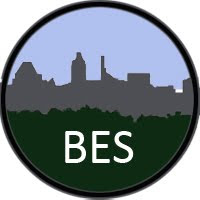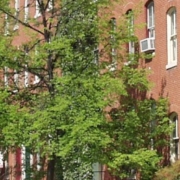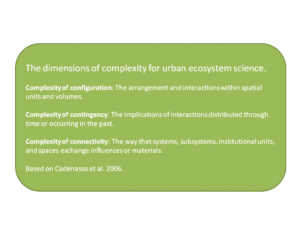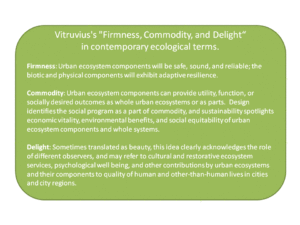Where Does the Baltimore School of Urban Ecology Apply?
The short answer is “Not just in Baltimore.” Let’s explore this more deeply. A school of thought is a broad way of thinking, strategy for research, and approach to problem solving that applies across a topic area. A school of thought may be named for a particular place where it originated while applying to any place where its assumptions are met. So the Baltimore School of Urban Ecological Science is a way of thinking that potentially applies to urban, urbanizing, and changing urban places anyplace on Earth.
Four Broad Propositions of the Baltimore School
To examine the potential for broad application, the nature of the Baltimore School must be described. According to Grove and colleagues (2015), the Baltimore School rests on four big theoretical propositions.
- Urban ecological science addresses the whole urban mosaic, not just the green spots.
- Urban systems are complex in space, time, and organization.
- It is an integrative pursuit dealing with whole urban areas as human-ecological-technological systems.
- Ecology of cities is useful for both scientific understanding and decision making.
The first three propositions embody many more specific scientific assumptions, frameworks, and concepts, while the fourth emphasizes the integration of science with decision making as a co-produced goal and outcome. Each of these propositions encompasses more specific assumptions, that together show what the Baltimore School is and why it can apply so broadly.
The task of testing the broad relevance of the Baltimore School rests on the meaning and applicability of the four theoretical propositions. The Baltimore School would be relevant wherever these four propositions or tenets hold.
Comprehensive mosaics
 |
| Union Square corner |
Although urban places were for centuries walled and distinct features of landscapes and regions, differing in structure and activities from surrounding rural, pastoral, or wild lands, this distinction has virtually dissolved over the last century (Lefebvre 2003, Gandy 2014). Of course even ancient, Medieval, or Baroque cities had contrasting districts within them, represented by the familiar term “quarter” still heard in many cities. But to this fine scale and confined mosaic of structure and use, contemporary cities add many layers of heterogeneity. And such heterogeneity is seen in various aspects of urban form, for example. It is common now to speak of various “shades” of infrastructure — green for vegetation, blue for water and wetlands, gray for buildings or pavement. There are also spatially distributed social structures and infrastructures, and of course some technological infrastructures such as wires and wireless aren’t usually represented by a color, being virtually invisible to most urbanites. Yet these various constructed, biological, and social elements are combined in different ways across a city, suburban, and exurban region. Indeed urban infrastructures in the largest sense also reach into seemingly rural parts of urban regions.
Urban systems are therefore now mosaics of all these various features and their patchy structures exhibit different kinds and degrees of connection, support or dampen flows of materials, energy, organisms, and information, and change over various time scales (McGrath and Shane 2012, Boone et al. 2014). These extensive mosaics are the subject of urban science and are the motivation for investigating the ecology of the city (Pickett et al. 1997, Grimm et al. 2000), where the term city stands for all the kinds and locations of elements listed above.
Complex in Space, Time, and Organization
A comprehensive mosaic such as that described under proposition one must be considered a complex system in the sense of encompassing different scales, of possessing non-linear interactions and feedbacks, undergoing adaptation and learning, and exhibiting open ended trajectories of change. Complexity is thus different from complicatedness, which characterizes systems that may have many interacting parts, but in which the interactions are fixed and functions, goals, or end points are clear (Allen and Hoekstra 2015). Cities are clearly systems of the complex type.
Complexity can be conceived of as having three conceptual dimensions (Cadenasso et al. 2006). Space, time, and organization. Each dimension can be represented by a nested hierarchy ranging from relatively less to relatively more complex situations.
Spatial complexity begins with a focus on individual locations or patches. The simplest description of a spatial mosaic is to enumerate the kinds of patches or spatial units it contains. Increasing complexity emerges from understanding the frequency of each of the types of units. Further complexity appears when the spatial configuration or adjacencies of the patches are accounted for. The next step of spatial complexity is to document patch change, which may involve appearance of new patch types, disappearance of existing patch types, or the merging or splitting of different patches. Finally, accounting for all these lower levels of complexity the shifting mosaic or fully patch dynamic system can be addressed. This dimension of complexity might also be called complexity of configuration since that idea encompasses and depends upon the specific steps of complexity laid out just above.
 |
| W 29th Street, Baltimore |
Temporal complexity exists when research and practical concern extends from focus on the here and now, with the interactions that occur instantaneously in that scope, to increasing depths of time and history. As complexity addresses additional time periods, such things as echoes of past events or conditions, legacies of prior social or biophysical regimes, and finally the emergence of interactions that take a long time to come to fruition appear for analysis and may impact management (Boone 2007, Grove et al. 2017). Scenario building takes temporal complexity as a reality that can be explored via alternative trajectories of change into the future (Carpenter et al. 2006, Larondelle et al. 2016). This complexity can also be labeled complexity of contingency.
Organizational complexity acknowledges that the control of individual components or networks of components in an urban system depend on how those units interact. Along the organizational dimension, complexity increases a step when neighboring patches come under consideration. This step implies a third possible step, the nature of the boundaries between patches, which invokes a fourth step of flow from patch to patch. Flows as well as changes within the individual patches are the next step in complexity, which ends in the capstone consideration of entire spatial patch mosaics as hosting connectivity and change. This dimension of complexity suggests several urban applications, including nested hierarchies of households, neighborhoods, districts, municipality, and so on, up to a megaregion (Harrison and Hoyler 2014). The complexities of space and connection also extend to the entire urbanized globe through material, energetic, and informational teleconnections (Seto et al. 2012). Human migration also knits the spatially complex global urban realm together in increasingly intimate and sometimes problematic ways. This dimension of complexity could also be labeled complexity of connectivity.
Urban systems can exhibit all three kinds of complexity and may do so over vast extents, involving many social, political, economic, and technological as well as biophysical conditions. This suggests that urban ecological science is an interdisciplinary field that engages with many others (McIntyre et al. 2000, McPhearson et al. 2016). This idea is made explicit in the next proposition of the Baltimore School.
Integrated Social-Ecological-Technological Systems
Ecology has been since its birth as a scientific field a preeminently integrative, synthetic, and process oriented one (Kingsland 2005). When applied to urban systems, this integrative motive is extraordinarily important. Among the many integrative concepts in ecology, the idea of the ecosystem may express this motivation most fundamentally. The core term “system” requires there to be components, interactions, feedbacks, and a stated boundary. Notably, the boundary may not be “hard” (Cadenasso et al. 2003). Adding “ecological” to this idea’ represented by the now nearly ubiquitous prefix “eco,” took these requirements into the biological realm. The ecosystem is defined as the interactionbetween a biotic complex, that is, a community of all kinds of organisms, with a physical complex, that is all the resources, regulating factors, stresses, and physical signals in a particular space (Pickett and Cadenasso 2009). Ecological space was therefore conceived from the beginning as process-based and integrative. This is quite helpful in the urban realm, where social scientists and philosophers have for a long time spoken of the social creation of space in urban areas (Lefebvre 1991). We can now see that there is also ecological creation of space to go along with that, and the ecosystem concept carries that conceptual weight successfully. In other words, urban space is co-produced by social and biophysical processes (Rademacher et al. 2018).
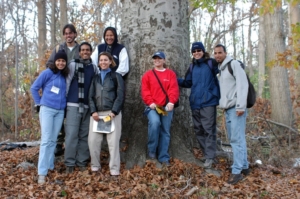 |
| Ecological Society of America SEEDS student field trip to Balto, 2003 |
Applying the ecosystem idea to urban systems is important for several reasons. First, it helps translate the ideas of complex systems to urban areas. Second, it reminds everybody that organisms in addition to people are present in all urban places. Third, it invites everybody to recognize and exploit the work — both beneficial and burdensome — that the organisms do in urban systems. This last point is important even if the organisms aren’t obvious or visible to all.
There are some caveats in using the ecosystem idea to apply to urban systems. First, some people have attributed to the ecosystem idea in general what are actually specific assumptions of particular models or narrow uses of the general idea. Although these assumptions may hold in some specific situations, it is not wise to assume that all ecosystems are in equilibrium, are resistant to change, are self regulating, or alternatively, that they are delicate and ephemeral, or that they necessarily have some desired social goal. There are lots of other kinds of baggage that the term ecosystem sometimes carries, but those bags are really carried by and should be evaluated in the context of the specific models that translate the general term to clearly stated situations. This insight comes from a hierarchical view of general theory, that is supported by more less general or specific models where the special assumptions actually reside (Cadwallader 1988, Pickett et al. 2007).
So now we can summarize what, in general terms, an urban ecosystem is following the tenets of the Baltimore School. This brings together thinking that has been exercised in various projects and institutions (e.g., Grove 2015, Pickett et al. 2011, 2019). An urban ecosystem is the interaction among a biotic component, a physical component, a social component, and a constructed component. These four components are very high level generalizations that must be further unpacked or specified to create a rigorous model of an urban place at any particular scale or location. Social, as used here, includes such things as human demography and group identities, economics, power and politics, culture, and governance. Many other specific features of the social component could be given. The constructed includes the reshaping of the land surface, modification of soils and substrates, shifts in hydrological flows, pipes, wires, buildings, and roads. Again, more detail of the constructed component can be given in any particular place. The biotic and the physical in the urban ecosystem have the same broad meaning as they do in the original ecosystem definition. But it is well known that biota and physical features of urban systems can be and very often are profoundly modified by human products and activities (Pouyat et al. 2010, Swan et al. 2011). But to neglect the persistent role of organisms and the deep physical context is to fail to take advantage of cities at least in part as ecological systems (Spirn 1984, 2012). Among other things, neglecting the biological and the physical:
- reduces the likelihood of successful “nature based solutions” to urban problems,
- neglects the biological capacities to reduce the work required of gray infrastructure,
- neglects people’s delight in the biota of their city, suburban, and exurban places, or
- obscures the impact of rare extreme natural events.
Use-Inspired Basic Research: Ecology For the City
Discussing how the ecosystem concept resonates with the ancient architectural criteria of “firmness, commodity, and delight” (translated from the Roman architect and engineer, Vitruvius, 1st century BCE). These three desiderata of the built environment have implications for how we view a city through an ecological lens, and highlight the proposition that urban ecological science has contributions to make to solving practical problems in urban areas. This ancient triumvirate of characteristics from architecture points to some appropriate desires for the four components — biotic, physical, social, and constructed — of urban ecosystems. Firmness of course means that the components will be safe, sound, and reliable. How does this apply to the biotic and the constructed components of urban systems? The concepts of resilience and robustness link this to contemporary urban concerns. These ecological aspects of the ecosystem components point to the fact that firmness does not mean unchanging. Commodity refers to the utility, function, or outcomes of the parts of the urban ecosystem. Here contemporary parlance might speak of the social program of designed or planned parts of a city-suburb-exurb. But the three pillars of sustainability help spotlight economic vitality, environmental benefits, and social equitability of urban features and plans. Delight or beauty, clearly in the eyes of the beholders, speaks to such things as cultural and restorative ecosystem services, psychological well being, and other contributions of all components of urban ecosystems to quality of human and other-than-human lives in urban regions.
The Baltimore School emerged in part from the desire to address the practical and pressing concerns to improve the quality of life throughout the city region — but not neglecting underserved, minority and poor neighborhoods — to improve the quality of environment downstream in the impaired waters of the Chesapeake Bay, and to provide non-governmental organizations, government agencies, and the local school systems with reliable scientific information. It is clear that similar goals can be found for old and emerging cities around the globe. In meeting these practical goals, the Baltimore School became a trusted venue — not necessarily always a physical location — but an intellectually open community, to facilitate conversations among organizations and agencies in the region that sometimes were siloed and isolated.
This tenet can be summarized in the phrase “ecology for the city” (Childers et al. 2015). Two caveats: First city, as throughout this essay, refers to all parts of a large, comprehensive urban region. Second, “for” does not mean a top down, one size fits all, or paternalistic approach to generating and applying ecological insights in urban areas. Rather for means with. With implies that some research questions, study approaches, analyses, and interpretations will be co-produced by scientists working with communities, civic organizations, and government agencies (Muñoz-Erickson et al. 2017). Educational curricula will likewise be developed in collaboration with teachers and school administrators.
Difference From Other Urban Schools.
This section is something of an interlude. The cymbal crash has occurred just above. This essay has endeavored to show that the Baltimore School is not just a child or advocate of one metropolitan region in one country. Rather, it is a way of thinking that can be used anywhere. But how does it differ from other schools of urban ecology? This discussion isn’t meant to identify all possible named schools of urban ecology. In fact, some schools might be considered schools of urbanism, which often rest on architectural, planning, design, social, and economic concerns rather than environmental or ecological ones (e.g., Ellin 2006, McGrath 2013).
The Chicago School
The reason that most people talk about urban schools at all is the Chicago School of Urban Sociology. Some sources call this a school or urban ecology, however. This was the pioneering school of urban sociology in the United States, flourishing in the first two decades of the twentieth century (Burgess 1925). A product of the first department of sociology in the United States, the professors borrowed many analogies from the predominant plant ecology of the time (Light 2009). Communities as units, succession or linear, deterministic dynamics of communities through time, and a distinct spatial zonation of human communities in Chicago were some of the most important ideas of the Chicago School (Cadenasso and Pickett 2013). As early as the 1930s and continuing into the mid-twentieth century, the Chicagoans were criticized for over-idealizing the spatial and deterministic transitions, and for neglecting human behavior, for example (Hawley 1986, Burch et al. 2017). Critics thought that space was being used as a determinant, rather than a stage for more subtle, open-ended human interaction. In addition, the idea of urban life cycles, brought in by analogy from ecology, was used as late as the 1960s to justify federal funding of massive neighborhood replacement and highway building that has often disadvantaged poor and minority groups. Unfortunately, the fact that the term ecology is sometimes used for this school has led the more recent explorations of ecologists into the city to be tarred with the same broad brush (e.g., Gottdiener and Hutchison 2000). The invention of the term Baltimore School was intended to offer a counterweight to this misinterpretation of urban ecological science.
The Los Angeles School
First articulated in the 1990s, the Los Angeles School is not primarily an environmental view of the city. However, it does offer an alternative to the paradigm of modernism that was the context for the formation and legacies of the Chicago School (Dear and Flusty 1998). It suggested that contemporary structures and dynamics in large city regions, especially those which emerged predominantly after World War II, should be understood in terms of post-modernism. Dear and Flusty, for example, highlight the spatial complexity of post-modern urbanism, the importance of local-global connections, the strong social differentiation in cities, and the shift of control from core cities to suburban and exurban institutions and processes. Although these urbanistic shifts have environmental implications, making those connections remains a task for urban ecological science and the interdisciplinary nexus it participates in (McHale et al. 2015).
Applying the Baltimore School: Summary and Prospects
This essay has drawn on a broad foundation of urbanist thinking, which are referenced elsewhere (Shane 2005, Pickett et al. 2011, McGrath 2013, Grove et al. 2015). Here we have made presented three key points.
1. The Baltimore School of Urban Ecological Science emerged from work, experience, and practice in Baltimore, but it applies to any situation where its tenets hold. It addresses places where systems are co-produced by social and biophysical processes.
2. The tenets are that first urban areas are comprehensive and extensive urban ecosystems, best studied as complete mosaics of land, cover, and habitat types; second urban systems are complex in the technical sense along dimensions of space, time, and organization (that is configuration, contingency, and connectivity); third they are integrated social ecological systems (equivalently labeled as human ecosystems or social-ecological-technological systems); and fourth the perspectives above and the empirical understanding they support is useful for co-produced decision making by individuals, households, organizations, and government agencies.
3. These tenets, as theoretical propositions and paradigmatic assumptions, are clearly broadly relevant to urban areas across the globe, and at any scale of settlement structure and connectivity. Therefore the Baltimore School stands for a universal social-ecological conceptual and epistemological device that can structure urban ecological science in any location.
Literature Cited
- Allen, T. F. H., and T. W. Hoekstra. 2015. Toward a unified ecology. 2nd edition. Columbia University Press, New York.
- Boone, C. G. 2007. Legacy effects on environmental equity in Baltimore and Phoenix: a cross site analysis.
- Boone, C. G., C. L. Redman, H. Blanco, D. Haase, J. Koch, S. Lwasa, H. Nagendra, S. Pauleit, S. T. A. Pickett, K. C. Seto, and M. Yokohari. 2014. Reconceptualizing land for sustainable urbanity. Pages 313–330 in K. C. Seto and A. Reenberg, editors. Rethinking urban land use in a global era. MIT Press, Cambridge.
- Burch, W. R., Jr., G. E. Machlis, and J. E. Force. 2017. The Structure and Dynamics of Human Ecosystems: Toward a Model for Understanding and Action. Yale University Press, New Haven.
- Burgess, E. W. 1925. The growth of the city: an introduction to a research project. Pages 47–62 The city. University of Chicago Press, Chicago.
- Cadenasso, M. L., and S. T. A. Pickett. 2013. Three tides: the development and state of the art of urban ecological science. Pages 29–46 in S. T. A. Pickett, M. L. Cadenasso, and B. McGrath, editors. Resilience in ecology and urban design: linking theory and practice for sustainable cities. Springer, New York.
- Cadenasso, M. L., S. T. A. Pickett, and J. M. Grove. 2006. Dimensions of ecosystem complexity: Heterogeneity, connectivity, and history. Ecological Complexity 3:1–12.
- Cadenasso, M. L., S. T. A. Pickett, K. C. Weathers, and C. G. Jones. 2003. A framework for a theory of ecological boundaries. Bioscience 53:750–758.
- Cadwallader, M. 1988. Urban geography and social theory. Urban Geography 9:227–251.
- Carpenter, S. R., E. M. Bennett, and G. D. Peterson. 2006. Scenarios for ecosystem services: an overview. Ecology and Society 11:29.
- Childers, D. L., M. L. Cadenasso, J. M. Grove, V. Marshall, B. McGrath, and S. T. A. Pickett. 2015. An Ecology for Cities: A Transformational Nexus of Design and Ecology to Advance Climate Change Resilience and Urban Sustainability. Sustainability 7:3774–3791.
- Dear, M., and S. Flusty. 1998. Postmodern urbanism. Annals of the Association of American Geographers 88:50–72.
- Ellin, N. 2006. Integral Urbanism. Taylor & Francis, New York.
- Gandy, M. 2014. Where does the city end? Pages 86–89 in N. Brenner, editor. Implosions/explosions: towards a study of planetary urbanization. jovis Verlag, Berlin.
- Gottdiener, M., and R. Hutchison. 2000. The New Urban Sociology. McGraw Hill, New York.
- Grimm, N., J. M. Grove, S. T. A. Pickett, and C. Redman. 2000. Integrated Approaches to Long-Term Studies of Urban Ecological Systems. BioScience 50:571–584.
- Grove, M., M. L. Cadenasso, S. T. A. Pickett, G. Machlis, and W. R. Burch Jr. 2015. The Baltimore school of urban ecology: space, scale, and time for the study of cities. Yale University Press, New Haven.
- Grove, M., L. Ogden, S. Pickett, C. Boone, G. Buckley, D. H. Locke, C. Lord, and B. Hall. 2017. The Legacy Effect: Understanding How Segregation and Environmental Injustice Unfold over Time in Baltimore. Annals of the American Association of Geographers 0:1–14.
- Harrison, J., and M. Hoyler. 2014. Megaregions. Globalization’s new urban form? Edward Elgar, London.
- Hawley, A. 1986. Human Ecology. University of Chicago Press, Chicago.
- Kingsland, S. E. 2005. The Evolution of American Ecology, 1890-2000. Johns Hopkins University Press.
- Larondelle, N., N. Frantzeskaki, and D. Haase. 2016. Mapping transition potential with stakeholder- and policy-driven scenarios in Rotterdam City. Ecological Indicators 70:630–643.
- Lefebvre, H. 1991. The production of space. Blackwell, Oxford.
- Lefebvre, H. 2003. The urban revolution. Page (R. Bononno, Tran.). University of Minnesota Press, Minneapolis.
- Light, J. S. 2009. The nature of cities: ecological visions and the American urban professions 1920-1960. Johns Hopkins University Press, Baltimore.
- McGrath, B. P., editor. 2013. Urban design ecologies. John Wiley and Sons, Ltd, Hoboken.
- McGrath, B., and G. Shane. 2012. Introduction: metropolis, megalopolis, and metacity. Page in C. G. Crysler, S. Cairns, and H. Heynen, editors. The SAGE handbook of architectural theory. SAGE, Washington, DC.
- McHale, M. R., S. T. A. Pickett, O. Barbosa, D. N. Bunn, M. L. Cadenasso, D. L. Childers, M. Gartin, G. R. Hess, D. M. Iwaniec, T. McPhearson, M. N. Peterson, A. K. Poole, L. Rivers, S. T. Shutters, and W. Zhou. 2015. The new global urban realm: complex, connected, diffuse, and diverse social-ecological systems. Sustainability 7:5211–5240.
- McIntyre, N. E., K. Knowles-Yánez, and D. Hope. 2000. Urban ecology as an interdisciplinary field: differences in the use of “urban” between the social and natural sciences. Urban Ecosystems 4:5–24.
- McPhearson, T., S. T. A. Pickett, N. B. Grimm, J. Niemelä, M. Alberti, T. Elmqvist, C. Weber, J. Breuste, D. Haase, and S. Qureshi. 2016. Advancing Urban Ecology Towards a Science of Cities. BioScience 66:198–212.
- Muñoz-Erickson, T. A., C. A. Miller, and T. R. Miller. 2017. How Cities Think: Knowledge Co-Production for Urban Sustainability and Resilience. Forests 8:203.
- Pickett, S. T. A., and M. L. Cadenasso. 2009. Altered resources, disturbance, and heterogeneity: a framework for comparing urban and non-urban soils. Urban Ecosystems 12:23–44.
- Pickett, S. T. A., M. L. Cadenasso, J. M. Grove, C. G. Boone, P. M. Groffman, E. Irwin, S. S. Kaushal, V. Marshall, B. P. McGrath, C. H. Nilon, R. V. Pouyat, K. Szlavecz, A. Troy, and P. Warren. 2011. Urban ecological systems: scientific foundations and a decade of progress. Journal of Environmental Management 92:331–362.
- Pickett, S. T. A., W. R. B. Jr, S. E. Dalton, and T. W. Foresman. 1997. Integrated urban ecosystem research. Urban Ecosystems 1:183–184.
- Pickett, S. T. A., J. Kolasa, and C. G. Jones. 2007. Ecological Understanding: The Nature of Theory and the Theory of Nature. 2nd edition. Academic Press, San Diego.
- Pouyat, R. V., K. Szlavecz, Y. D. Yesilonis, P. M. Groffman, and K. Schwarz. 2010. Chemical, physical, and biological characteristics of urban soils. Pages 119–152 in J. Aitkenhead-Peterson and A. Volder, editors. Urban Ecosystem Ecology. American Society of Agronomy and Crop Science Society of America, Madison, WI.
- Rademacher, A., M. L. Cadenasso, and S. T. A. Pickett. 2018. From feedbacks to coproduction: Toward an integrated conceptual framework for urban ecosystems. Urban Ecosystems.
- Seto, K. C., A. Reenberg, C. G. Boone, M. Fragkias, D. Haase, T. Langanke, P. Marcotullio, D. K. Munroe, B. Olah, and D. Simon. 2012. Urban land teleconnections and sustainability. Proceedings of the National Academy of Sciences of the United States of America 109:7687–7692.
- Shane, D. G. 2005. Recombinant urbanism: conceptual modeling in architecture. John Wiley & Sons, Hoboken.
- Spirn, A. W. 1984. The granite garden: urban nature and human design. Basic Books, New York.
- Spirn, A. W. 2012. Ecological urbanism: a framework for the design of resilient cities. http://www.annewhistonspirn.com/pdf/Spirn-EcoUrbanism-2012.pdf.
- Swan, C. M., S. T. A. Pickett, K. Szlavecz, P. Warren, and K. T. Willey. 2011. Biodiversity and community composition in urban ecosystems: coupled human, spatial, and metacommunity processes. Pages 179–186 in J. Niemelä, editor. Handbook of Urban Ecology. Oxford University Press, New York.
For an earlier post with background information, see also https://besdirector.blogspot.com/2015/12/a-new-school-of-urban-ecology.html
Steward Pickett, Director Emeritus
Steward Pickett, Director Emeritus
